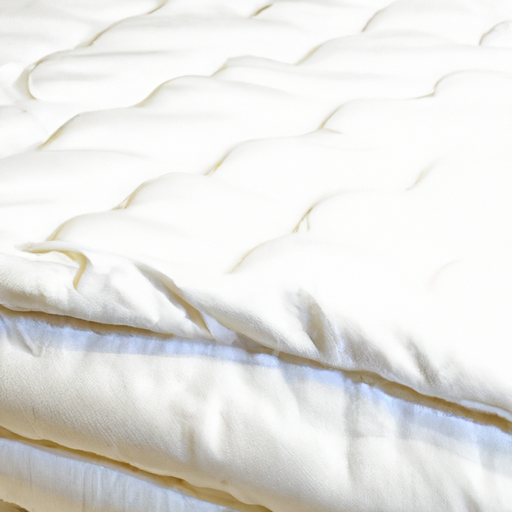If you’ve ever wondered how frequently you should be washing your mattress protector, you’re not alone. Keeping your mattress clean and free from stains is essential for maintaining its longevity and ensuring a comfortable sleep environment. In this article, we’ll provide you with some valuable insights and tips to help you determine the ideal frequency for washing your mattress protector. From the importance of regular cleaning to practical guidelines, we’ve got you covered. So, let’s dive into the world of mattress protector maintenance and find out how often you should be washing yours.
Review contents
Factors to consider
Material of the mattress protector
When it comes to choosing a mattress protector, the material is an important factor to consider. Different materials can offer varying levels of comfort, breathability, and protection. Some commonly used materials for mattress protectors include cotton, polyester, bamboo, and waterproof materials like vinyl or polyurethane. Depending on your preferences and needs, you may opt for a soft and comfortable cotton or bamboo protector, or you may prefer the waterproof protection of vinyl or polyurethane.
Frequency of use
The frequency of use of your mattress protector plays a significant role in determining how often you should wash it. If you use the protector every night, it will accumulate more sweat, body oils, and skin cells compared to occasional use. In general, the more frequently you use the mattress protector, the more often it will need to be washed.
Health conditions
If you or someone in your household has certain health conditions, it may be necessary to wash the mattress protector more frequently. Conditions such as allergies, asthma, or eczema can lead to increased dust mite activity, making regular washing essential to maintain a clean and healthy sleep environment.
Presence of pets or children
If you have pets or children who frequently share the bed with you, the mattress protector may be exposed to additional dirt, stains, and accidents. Accidental spills, pet hair, and pet dander can accumulate on the surface of the protector, necessitating more frequent washing.
Climate and environment
The climate and environment in which you live can also impact the frequency of mattress protector washing. In hot and humid climates, you may sweat more during sleep, leading to more frequent washing. Additionally, if your bedroom is prone to dust or if you live in an area with higher pollen levels, it may be necessary to wash the protector more often to reduce allergens.
General guidelines
Manufacturer’s recommendations
Always refer to the manufacturer’s recommendations for washing and caring for your specific mattress protector. Different protectors may have different care instructions based on the materials used.
Minimum frequency
As a general guideline, it is recommended to wash your mattress protector at least every two to three months. This timeframe allows for regular maintenance and ensures that the protector remains clean and free from buildup.
Visible stains or spills
If you notice any visible stains or spills on your mattress protector, it is important to wash it promptly. Stains can set in over time and become more difficult to remove if left untreated.
Bed-sharing or co-sleeping
If you share your bed with a partner or child, it is advisable to wash the mattress protector more frequently. Bed-sharing increases the chances of spills, accidents, and increased sweat and body oil accumulation.
Personal preference
Ultimately, the frequency of washing your mattress protector may also depend on personal preference. If you prefer the feeling of freshly washed bedding or have specific concerns about cleanliness, you may choose to wash it more often than the recommended minimum frequency.
Regular maintenance
Regular vacuuming
In addition to washing, regular vacuuming can help keep your mattress protector clean and free from dust, allergens, and debris. Use a handheld vacuum or a vacuum cleaner with a brush attachment to gently remove any surface dirt and particles.
Spot cleaning
If you notice any localized stains or spills on your mattress protector, spot cleaning can be an effective way to remove them without having to wash the entire protector. Use a mild detergent or stain remover, following the instructions provided by the manufacturer, and gently dab the affected area with a clean cloth or sponge. Avoid rubbing the stain, as this can spread it and push it deeper into the fabric.
Air drying
When it comes to drying your mattress protector, air drying is generally recommended. This helps maintain the integrity of the material and prevents shrinkage or damage that can occur with high heat. Hang the mattress protector outdoors or in a well-ventilated area and allow it to air dry completely before putting it back on the bed.
Protecting the mattress
While the primary purpose of a mattress protector is to safeguard the mattress, it is important to remember that the protector itself needs protection. Regularly washing your mattress protector helps maintain its effectiveness and prolong its lifespan. By keeping the protector clean, you are also ensuring that it continues to provide a barrier against allergens, dust mites, and spills.
Machine wash
Types of mattress protectors
Before washing your mattress protector, it is important to understand the type of protector you have. Some protectors are designed to be machine washable, while others may require alternative cleaning methods. Check the care label or the manufacturer’s instructions to determine if your protector is machine washable.
Instructions on care label
Always follow the instructions provided on the care label of your mattress protector. The care label will provide specific guidelines on water temperature, washing cycle, and detergent recommendations.
Water temperature
In most cases, a cool or warm water temperature setting is suitable for washing your mattress protector. Avoid using hot water, as this can damage certain materials or cause shrinkage. Refer to the care label for specific temperature recommendations.
Detergent choice
When choosing a detergent for washing your mattress protector, opt for a mild and hypoallergenic option. Harsh detergents or those containing bleach or strong fragrances can damage the fabric or cause allergic reactions. Read the detergent labels and select one that is suitable for delicate fabrics.
Spin cycle and drying
When washing your mattress protector, use a gentle or delicate cycle to minimize agitation and potential damage to the fabric. After washing, it is best to air dry the protector by hanging it or laying it flat. Avoid using high heat settings in the dryer, as this can lead to shrinkage or damage.
Dry cleaning
Suitable protectors
Some mattress protectors may require dry cleaning instead of machine washing. Check the care label or the manufacturer’s instructions to determine if your protector is suitable for dry cleaning.
Professional cleaning
If your mattress protector requires dry cleaning, it is recommended to take it to a professional cleaner. They have the expertise to effectively clean delicate fabrics without causing damage. Follow their instructions for drop-off and pickup times, as well as any additional care guidelines they provide.
Frequency
Dry cleaning your mattress protector may not be required as frequently as machine washing, but it is still important to do so when necessary. Follow the care instructions provided by the manufacturer or consult with the professional cleaner for guidance on how often the protector should be dry cleaned.
Cost considerations
It is important to consider the cost associated with dry cleaning your mattress protector. Unlike machine washing, which can be done at home, dry cleaning often requires additional fees. This should be factored into your decision-making process, especially if frequent dry cleaning is necessary.
When to wash after spills or accidents
Urine or pet accidents
If you or your pet has an accident on the mattress protector, it is crucial to wash it as soon as possible. Urine and other bodily fluids can stain and cause odor if left untreated. Immediate washing can minimize the risk of permanent damage or lingering smells.
Spilled liquids or foods
For spills involving liquids or foods, it is best to wash the mattress protector promptly. Stains from beverages, sauces, or other food items can set in quickly and become more challenging to remove if not treated promptly.
Bodily fluids or secretions
If there are any bodily fluids or secretions on the mattress protector, such as blood, sweat, or saliva, it is important to wash it immediately. These fluids can contain bacteria and pathogens that can lead to odors, stains, or even health concerns if left unattended.
Signs of a dirty mattress protector
Odor or foul smell
A foul smell or unpleasant odor emanating from your mattress protector is a clear sign that it needs washing. Sweat, body oils, and other substances can accumulate over time, causing the protector to develop an unpleasant smell.
Visible stains or discoloration
Visible stains or discoloration on the mattress protector are clear indicators that it requires cleaning. Stains can come from bodily fluids, spills, or other sources, and they can worsen over time if not treated promptly.
Decreased protection level
Over time, the protective qualities of a mattress protector can deteriorate if it is not cleaned regularly. Dust mites, allergens, and spills can compromise the effectiveness of the protector, reducing its ability to protect the mattress and provide a clean sleep surface.
Allergies or respiratory issues
If you or someone in your household experiences an increase in allergies or respiratory issues, it may be a sign that the mattress protector is dirty and needs washing. A buildup of dust mites, allergens, or mold on the protector can trigger allergic reactions or exacerbate existing respiratory conditions.
Additional tips
Using a mattress encasement
Consider using a mattress encasement in addition to a mattress protector. A mattress encasement provides full coverage and protection for your mattress, acting as a barrier against allergens, dust mites, and spills. It can also help extend the lifespan of your mattress and reduce the need for frequent washing of the protector.
Rotation and flipping
Regularly rotating and flipping your mattress can help distribute weight evenly and prevent excessive wear and tear. This can minimize the transfer of sweat, body oils, and debris onto the mattress protector, reducing the frequency of washing.
Regular washing routines
Establishing a regular washing routine for your mattress protector can help ensure that it remains clean and fresh. Whether you choose to wash it every two to three months or more frequently, consistency is key in maintaining a hygienic sleep environment.
Conclusion
Keeping your mattress protector clean is essential for maintaining a healthy and comfortable sleep environment. Factors such as the material of the protector, frequency of use, health conditions, presence of pets or children, and climate all impact how often you should wash your mattress protector. Regular maintenance, machine washing or dry cleaning when necessary, and prompt washing after spills or accidents help ensure that your mattress protector remains clean, fresh, and effective in protecting your mattress. By following these guidelines and incorporating regular washing routines into your cleaning routine, you can enjoy a clean and comfortable sleep experience.




















